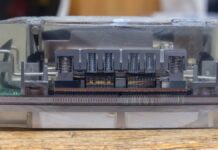Recently the Intel Xeon E3-1200 V3 product portfolio was leaked through an Intel document that was quickly taken down. Many sites leaked the content of the Intel Xeon E3-1200 V3 series but one request we got was to compare the leaked specs to previous versions. For those that are not aware, the Intel Xeon E3-1200 V3 series is the first departure from the LGA1155 platform that was present for the Xeon E3-1200 V1 and V2 lines. Whereas the Xeon E3-1200 V1 was based on Intel’s Sandy Bridge architecture and the Xeon E3-1200 V2 was based on the die shrunk updated Ivy Bridge architecture, the new generation is a major change. The Haswell-based V3 series is still based on 22nm tri-grate lithography but is a microarchitecture improvement over Sandy Bridge and Ivy Bridge meaning clock for clock Haswell should be 0-15% faster.
We have some data now both from Wikipedia and the leaked information online. In the leaked data set the Intel Xeon E3-1230L V3 had 8MB of L3 cache but since it is a dual core four thread CPU, it makes sense to be a 4MB part like the Intel Xeon E3-1220L V3. Here is a quick breakdown of the models over time.

One very interesting point here is that the Intel Xeon E3 lineup will have nine models where the model number has survived all three generations of the CPUs. New in the Intel Xeon E3-1200 V3 generation will be the Intel Xeon E3-1230L V3 a low power, 2C/ 4T part. The Xeon E3-1285L V3 may end up being a very popular part with fairly high clock speed, lots of cores and a significantly lower TDP. With the overall platform considered, it is likely the Intel Xeon E3-1285L is going to provide more than twice the performance/w over the Intel Xeon E3-1230L V3. On the standard power front the Intel Xeon E3-1285 V3 will provide a higher-end GPU alternative which may be interesting for professional workstation users who can handle a lower memory limit.
Another extremely interesting data point is that the Intel Xeon E3-1200 V3 rumored TDPs appear to be higher than the Intel Xeon E3-1200 V2 series and closer to what we saw in many cases with the V1 series Xeons. The general expectation for months has been that the Haswell generation will bring lower power parts. It is still too early to see if this is true, but even from our early Intel Xeon E3-1200 V2 series benchmark, one of the major benefits of Ivy Bridge over Sandy Bridge generations was higher clocks at lower power figures. It appears as though the Intel Xeon E3-1200 V3 Haswell generation parts will have similar clock speeds, and offer clock for clock performance boosts.
One of the major changes is that Haswell will have a fully integrated voltage regulator. That moves a motherboard component to the chip, possibly raising TDP. Also, the PCH will see a die shrink and gain a few new features. While actual chip TDP will go up to near Sandy Bridge levels in some cases, Haswell’s package will house more components than previous generations. Hopefully this leads to lower overall system power consumption and lower motherboard costs.
Of course, we will have a full lineup of benchmarks from the Intel Xeon E3-1200 V3 series when the chips launch in about two months (and hopefully before as we did with the Sandy Bridge and Ivy Bridge generations.
One ask is that we would love feedback on what tests the community would want to see in terms of benchmarks. Also, if there is something that sticks out as obvious to any of our readers in the new lineup, feel free to leave a comment or head over to the forums to discuss.





Why is the TDP higher for Haswell Xeons? Is it because Intel moved parts from the mobo, into the cpu? Or, are the rumours true: that Intel has problems with Haswell too high energy consumption?
I wonder aloud. think Intel did what they did with Clarksdale and have memory controller on the gpu so they can’t turn off the entire gpu? that would explain the higher power consumption.
too bad intel going in wrong way but will wait for final specs
Will these chips work with the C20X series chipsets? (will the supermicro board support these guys?)
No they won’t Ken. V3 is LGA1150 and V1/ V2 are LGA1155
Haswell has moved tech into the cpu, increasing TDP
http://www.extremetech.com/computing/152423-intel-goes-toe-to-toe-with-analysts-denies-haswell-has-power-issues